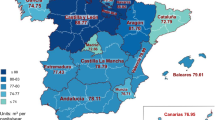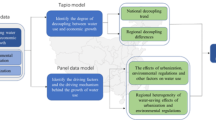Abstract
With the advancement of industrialization and urbanization, the issue of water shortage has become a bottleneck for China’s economic development. Based on the structural decomposition analysis and multi-regional input–output tables of China in 2002 and 2012, this paper explores the drivers of the change in China’s production water usage from the regional relevance perspective. Results show a significant increase in China’s production water usage during the study period. The relationship between production water usage and per capita GDP shows an inverted U-shaped curve, and the economic scale by provinces has been improved, while the trend of production water usage differs. There are rapid increases in production water usage in economically developing provinces, while it is falling sharply in developed provinces. The crucial factors promoting its growth are changes in consumption level, population scale, and regional economic patterns. The technical effect is the most important factor in curbing the growth, followed by effects of final demand sectoral and distribution structure. The provinces and sectors with more production water usage shows higher technical and final demand effects. Therefore, it is necessary to promote water-saving activities, enhance the water-saving technical effect, and optimize final demand structure to promote economic growth with low-water usage.












Similar content being viewed by others
Data availability
The datasets used and/or analyzed during the current study can be provided on reasonable request.
Notes
The Council Information Office of China held a press conference on February 16, 2012, and invited Hu Siyi, vice minister of the Ministry of Water Resources, to introduce the background and main contents of the “Opinions of the National Council on Implementing the Most Stringent Water Resources Management System.”
According to Zhang (2012), the mainland in China mainly consists of the following eight regions: northeast (NE, including Heilongjiang, Jilin, and Liaoning), Beijing-Tianjin region (BT, comprising Beijing and Tianjin), northern coast (NC, including Hebei and Shandong), eastern coast (EC, including Shanghai, Jiangsu, and Zhejiang), southern coast (SC, including Fujian, Guangdong, and Hainan), central region (CR, including Shanxi, Henan, Anhui, Hubei, Hunan, and Jiangxi), northwest (NW, including Inner Mongolia, Shaanxi, Ningxia, Gansu, Qinghai, and Xinjiang), and southwest (SW, including Sichuan, Chongqing, Guangxi, Yunnan, Guizhou, and Tibet).
This method takes into account the “non-uniqueness problem” in structural decomposition and has the advantage of simplified operation. It is a structural decomposition method, which is very suitable for empirical analysis (Zhang 2010).
References
Chen W, Wu S, Lei Y, Li S (2017) China’s water footprint by province, and inter-provincial transfer of virtual water. Ecol Indic 74:321–333. https://doi.org/10.1016/j.ecolind.2016.11.037
Dietzenbacher E, Los B (1998) Structural decomposition techniques: sense and sensitivity. Econ Syst Res 10(4):307–324. https://doi.org/10.1080/09535319800000023
Dong H, Geng Y, Fujita T, Fujii M, Hao D, Yu X (2014) Uncovering regional disparity of China’s water footprint and inter-provincial virtual water flows. Sci Total Environ 500–501:120–130. https://doi.org/10.1016/j.scitotenv.2014.08.094
Du Y, Wang X, Brombal D, Moriggi A, Sharpley A, Pang S (2018) Changes in environmental awareness and its connection to local environmental management in water conservation zones: the case of Beijing, China. Sustainability 10(6):2087. https://doi.org/10.3390/su10062087
Feng L, Chen B (2016) Scarce water footprint of energy production in China. Energy Procedia 88:176–181. https://doi.org/10.1016/j.egypro.2016.06.043
Feng K, Siu YL, Guan D, Hubacek K (2012) Assessing regional virtual water flows and water footprints in the Yellow River Basin, China: a consumption-based approach. Appl Geogr 32(2):691–701. https://doi.org/10.1016/j.apgeog.2011.08.004
Feng L, Chen B, Hayat T, Alsaedi A, Ahmad B (2017) The driving force of water footprint under the rapid urbanization process: a structural decomposition analysis for Zhangye city in China. J Clean Prod 163:s322–s328. https://doi.org/10.1016/j.jclepro.2015.09.047
Guan C, Chen B (2020) Driving factors of water-energy nexus in China. Appl Energy 257:113984. https://doi.org/10.1016/j.apenergy.2019.113984
Hang Y, Wang Q, Wang Y, Su B, Zhou D (2019) Industrial SO2 emissions treatment in China: a temporal-spatial whole process decomposition analysis. J Environ Manag 243:419–434. https://doi.org/10.1016/j.jenvman.2019.05.025
Hoekstra R, Van den Bergh JC (2003) Comparing structural decomposition analysis and index. Energy Econ 25(1):39–64. https://doi.org/10.1016/S0140-9883(02)00059-2
Kang J, Lin J, Zhao X, Zhao S, Kou L (2017) Decomposition of the urban water footprint of food consumption: a case study of Xiamen city. Sustainability 9(1):135. https://doi.org/10.3390/su9010135
Li M, Gao Y, Liu S (2020) China’s energy intensity change in 1997-2015: non-vertical adjusted structural decomposition analysis based on input-output tables. Struct Change Econ D 53:222–236. https://doi.org/10.1016/j.strueco.2020.03.001
Liang Y, Liang S, Xu L, Feng C, Qi J, Yang X, Li Y, Li K, Li H, Yang Z (2020) Socioeconomic drivers of water withdrawals driven by provincial energy demand in China. J Clean Prod 258:120971. https://doi.org/10.1016/j.jclepro.2020.120971
Magacho GR, McCombie JS, Guilhoto JJ (2018) Impacts of trade liberalization on countries’ sectoral structure of production and trade: a structural decomposition analysis. Struct Change Econ D 46:70–77. https://doi.org/10.1016/j.strueco.2018.04.003
Mou S, Yan J, Sha J, Li S, Ma Y, He G, Song C (2019) Dynamic simulation of the optimal allocation of water resources via the introduction of integrated water environmental policies in Baoding, China. Environ Sci Pollut R 26(26):27516–27533. https://doi.org/10.1007/s11356-019-05537-9
National Bureau of Statistics of China (2003) China statistical yearbook 2003. China Statistics Press, Beijing (in Chinese)
National Bureau of Statistics of China (2013a) China statistical yearbook 2013. China Statistics Press, Beijing (in Chinese)
National Bureau of Statistics of China (2013b) China economic census yearbook 2013. China Statistics Press, Beijing (in Chinese)
National Bureau of Statistics of China (2013c) Bulletin of first national census for water. China Statistics Press, Beijing (in Chinese)
Okushima S, Tamura M (2011) Identifying the sources of energy use change: multiple calibration decomposition analysis and structural decomposition analysis. Struct Change Econ D 22(4):313–326. https://doi.org/10.1016/j.strueco.2011.07.003
Research Group of Chinese Input–Output Association (2007) Input–output analysis of water resources consumption and water input coefficient in national economic sectors: the fifth of researching report series on input–output tables of 2002. Statistic Res 24(3):20–25 (in Chinese). https://doi.org/10.19343/j.cnki.11-1302/c.2007.03.004
Wang Z, Huang K, Yang S, Yu Y (2013) An input–output approach to evaluate the water footprint and virtual water trade of Beijing, China. J Clean Prod 42(3):172–179. https://doi.org/10.1016/j.jclepro.2012.11.007
Wang X, Huang K, Yu Y, Hu T, Xu Y (2016) An input–output structural decomposition analysis of changes in sectoral water footprint in China. Ecol Indic 69:26–34. https://doi.org/10.1016/j.ecolind.2016.03.029
Xie J, Su X (2017) Decomposition of influencing factors on irrigation water requirement based on LMDI method. Transact Chin Soc Agric Eng 33(7):123–131. https://doi.org/10.11975/j.issn.1002-6819.2017.07.016
Xu Y, Huang K, Yu Y, Wang X (2015) Changes in water footprint of crop production in Beijing from 1978 to 2012: a logarithmic mean divisia index decomposition analysis. J Clean Prod 87:180–187. https://doi.org/10.1016/j.jclepro.2014.08.103
Yang YX, Zhao X, Yang J (2015a) Accounting and impact of virtual water and water footprint in Xinjiang. China Popul Resour Environ 25(S1):228–232 (in Chinese)
Yang ZW, Xu XY, Chen W, Wang HR (2015b) Dynamic structural decomposition analysis model of water use evolution II: application. J Hydraul Eng 46(7):802–810 (in Chinese). https://doi.org/10.13243/j.cnki.slxb.20140553
Yang ZW, Xu XY, Wang HR, Chen W (2015c) Dynamic structural decomposition analysis model of water use evolution I: modeling. J Hydraul Eng 46(6):658–667 (in Chinese). https://doi.org/10.13243/j.cnki.slxb.20140553
Yang Z, Liu H, Xu X, Yang T (2016) Applying the water footprint and dynamic structural decomposition analysis on the growing water use in China during 1997–2007. Ecol Indic 60:634–643. https://doi.org/10.1016/j.ecolind.2015.08.010
Yu M, Zhao X, Gao Y (2019) Factor decomposition of China’s industrial electricity consumption using structural decomposition analysis. Struct Change Econ D 51:67–76. https://doi.org/10.1016/j.strueco.2019.08.002
Zhang YG (2010) Carbon contents of the Chinese trade and their determinants: an analysis based on non-competitive (import) input–output tables. China Econ Q 9(4):1287–1310 (in Chinese). https://doi.org/10.13821/j.cnki.ceq.2010.04.007
Zhang YX (2012) China’s inter-regional input-output tables in 2002 and 2007. China Statistics Press, Beijing (In Chinese)
Zhang YG (2018) Pathway and policy for regional coordinated low carbon development: perspective of spillover-feedback effects, 1st edn. Social Sciences Academic Press, Beijing (in Chinese)
Zhang B, Liu XL (2015) Structural decomposition analysis of impacting factors of China’s water consumption changes. Manag Rev 27(05): 3–8+18 (in Chinese). https://doi.org/10.14120/j.cnki.cn11-5057/f.2015.05.001.
Zhang Z, Yang H, Shi M (2011) Analyses of water footprint of Beijing in an inter-regional input–output framework. Ecol Econ 70(12):2494–2502. https://doi.org/10.1016/j.ecolecon.2011.08.011
Zhang ZY, Shi MJ, Yang H (2012) Understanding Beijing’s water challenge:a decomposition analysis of changes in Beijing’s water footprint between 1997 and 2007. Environ Sci Technol 46(22):12373–12380. https://doi.org/10.1021/es302576u
Zhang P, Zou Z, Liu G, Feng C, Liang S, Xu M (2020) Socioeconomic drivers of water use in China during 2002–2017. Resour Conserv Recycl 154:104636. https://doi.org/10.1016/j.resconrec.2019.104636
Zhao C, Chen B (2014) Driving force analysis of the agricultural water footprint in China based on the LMDI method. Environ Sci Technol 48(21):12723–12731. https://doi.org/10.1021/es503513z
Zhao X, Chen B, Yang ZF (2009) National water footprint in an input–output framework-a case study of China 2002. Ecol Model 220(2):245–253. https://doi.org/10.1016/j.ecolmodel.2008.09.016
Zhao X, Tillotson M, Yang Z, Yang H, Liu J (2016) Reduction and reallocation of water use of products in Beijing. Ecol Indic 61:893–898. https://doi.org/10.1016/j.ecolind.2015.10.043
Zhao X, Tillotson MR, Liu YW, Guo W, Yang AH, Li YF (2017) Index decomposition analysis of urban crop water footprint. Ecol Model 348:25–32. https://doi.org/10.1016/j.ecolmodel.2017.01.006
Zhao G, Gao C, Xie R, Lai M, Yang L (2019) Provincial water footprint in China and its critical path. Ecol Indic 105:634–644. https://doi.org/10.1016/j.ecolind.2018.06.058
Zhi Y, Yang ZF, Yin XA (2014) Decomposition analysis of water footprint changes in a water-limited river basin: a case study of the Haihe River Basin, China. Hydrol Earth Syst Sci 18(5):1549–1559. https://doi.org/10.5194/hess-18-1549-2014
Zhi Y, Yang Z, Yin XA, Hamilton PB, Zhang L (2015) Evaluating and forecasting the drivers of water use in a city: model development and a case from Beijing. J Water Resour Plan Manag 142(1):04015042. https://doi.org/10.1061/(ASCE)WR.1943-5452.0000548
Zhou X, Zhou D, Wang Q, Su B (2019) How information and communication technology drives carbon emissions: a sector-level analysis for China. Energy Econ 81:380–392. https://doi.org/10.1016/j.eneco.2019.04.014
Zhou X, Zhou D, Wang Q, Su B (2020) Who shapes China’s carbon intensity and how? A demand-side decomposition analysis. Energy Econ 85:104600. https://doi.org/10.1016/j.eneco.2019.104600
Acknowledgments
We thank the anonymous referees for their valuable comments to improve the quality of this paper.
Funding
This work was supported by the National Natural Science Foundation of China (NSFC) (Grant No. 71673083).
Author information
Authors and Affiliations
Contributions
Chao Gao contributed to data curation, formal analysis, and writing of the original draft. Rui Xie contributed to the conceptualization and methodology. Youguo Zhang contributed to the methodology, writing review, and editing. Kunfu Zhu contributed to the conceptualization, writing review, and editing.
Corresponding author
Ethics declarations
Competing interests
The authors declare that they have no competing interests.
Ethical approval
All analyses were based on published data in yearbook or literature, and no ethical approval and patient consents are required. Authors confirm that we have permission of the use of software and data in our study.
Consent to participate
There are no individual participants included in the study.
Consent to publish
The authors confirm that the work described has not been published before (except in the form of an abstract or as part of a published lecture, review, or thesis), that it is not under consideration for publication elsewhere, and that its publication has been approved (tacitly or explicitly) by the responsible authorities at the institution where the work is carried out. The copyright to the English language article is transferred to Springer effective if and when the article is accepted for publication. The authors warrant that their contributions are original and that they have full power to make this grant. The authors sign for and accept responsibility for releasing this material on behalf of any and all co-authors. The copyright transfer covers the exclusive right to reproduce and distribute the article, including reprints, translations, photographic reproductions, microform, electronic form (offline, online), or any other reproductions of similar nature.
Additional information
Responsible Editor: Philippe Garrigues
Publisher’s note
Springer Nature remains neutral with regard to jurisdictional claims in published maps and institutional affiliations.
Appendix. Sector classification
Appendix. Sector classification
Rights and permissions
About this article
Cite this article
Gao, C., Xie, R., Zhang, Y. et al. Drivers of dynamic evolution in provincial production water usage: perspective of regional relevance. Environ Sci Pollut Res 28, 15130–15146 (2021). https://doi.org/10.1007/s11356-020-11522-4
Received:
Accepted:
Published:
Issue Date:
DOI: https://doi.org/10.1007/s11356-020-11522-4
Keywords
- Regional economic pattern
- Structural decomposition analysis
- Multi-regional input–output model
- Production water usage




